How Do I Stop My Dog From Biting the Lead?
This is a common problem with puppies, but older dogs can also get into the habit of biting the lead when out for a walk. It’s a frustrating issue for owners and can occasionally be embarrassing. It can make for an unpleasant walk for all concerned if you have a puppy that refuses to let go of his, or her, lead. Holidays4Dogs offers some tips and suggestions on how to stop lead biting.
 Puppies especially, while they are being lead trained, can be frustrated by the constraint of a lead because all they want to do is be free and explore their surroundings. As a result, many resort to biting their leads. Stopping lead biting, however, can be frustrating for many owners.
Puppies especially, while they are being lead trained, can be frustrated by the constraint of a lead because all they want to do is be free and explore their surroundings. As a result, many resort to biting their leads. Stopping lead biting, however, can be frustrating for many owners.
Some breeds are more inclined to display lead biting behaviour. Terriers, for instance, can be quite feisty on the end of the lead.
Their instincts are to chase and kill prey, so when they are in a heightened state of excitement, they can transfer this to lead biting and tugging.
There are a few different techniques for stopping your dog from biting his lead. However, you may need to be a little patient, especially if your pup has been biting the lead for some time.
Teach calm behaviour while standing still.
 The first thing to do is to teach your dog to be calm while he is having his lead attached to his collar, or harness. This will go a long way to stopping your dog from lead biting. Clicker training is a successful method to approach issues such as lead biting . Begin by touching the lead and click and treat for calm behaviour, (no jumping up, or spinning allowed).
The first thing to do is to teach your dog to be calm while he is having his lead attached to his collar, or harness. This will go a long way to stopping your dog from lead biting. Clicker training is a successful method to approach issues such as lead biting . Begin by touching the lead and click and treat for calm behaviour, (no jumping up, or spinning allowed).
Next pick up the lead in your hand and again, click and treat for your dog remaining calm. If your dog gets excited, put the lead down and walk away. The final aim is to get your dog to have his lead attached while sitting nice and still. Click and treat for quiet behaviour.
Distraction tactics to stop lead biting.
Distraction is another way to reduce lead biting behaviour. Try tasty treats such as tiny pieces of cheese, or liver, and distract your dog from the lead chewing. As soon as he lets go of the lead, click and treat.
If your dog begins to chew and tug at his lead, let it go slack or better still (if you know he won’t run off), drop the lead altogether. Pulling back on the lead, or trying to prize it from his mouth, will almost certainly make him tug harder. To your dog this is a rewarding game.
dog begins to chew and tug at his lead, let it go slack or better still (if you know he won’t run off), drop the lead altogether. Pulling back on the lead, or trying to prize it from his mouth, will almost certainly make him tug harder. To your dog this is a rewarding game.
If you think your dog might run off, use a very long line or lead, so that once dropped, you can stand on the longer end if needs be.
Another good tip, is to teach your puppy the “leave it” command. Once your dog understands the leave it command, you can use this as a signal for him to drop the lead, (and reward when he does so).
Substitute lead biting for something else he can chew, such as long tug toy, or a ball on a rope. You can teach this separately from being on the lead. Teach him a cue to play with the tug toy and when to leave. Take the toy with you when you go on a walk and, if he walks without chewing the lead, reward him with a game of tug.
Conclusion.
Stopping your dog from lead biting can be frustrating. However, with patience it is usually possible to resolve the problem. The more you can reward the behaviour you want, the less the chewing behaviour will occur until, eventually, it should stop altogether. It may take a bit of time and patience, but it will be well worth it, for a tangle free walk!


